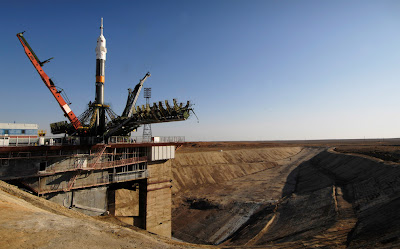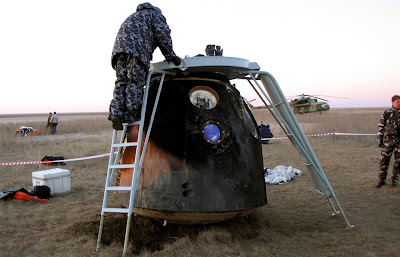


NASA astronaut Peggy A. Whitson, Expedition 16 commander, has a pressure suit leak check performed on her Russian Sokol launch and entry suit at RSC Energia Assembly and Testing Facility in Baikonur, Kazakhstan, in preparation for her launch on a Soyuz TMA-11 spacecraft to the International Space Station scheduled for Oct. 10. (NASA/Victor Zelentsov)
 The Baikonur Cosmodrome - part6
The Baikonur Cosmodrome - part6Russian cosmonaut Yuri Lonchakov (C), US astronaut Michael Fincke (L) and his compatriot, space tourist Richard Garriott (R) practice inside a Soyuz-TMA space flight simulator in Star City (a training facility north of Moscow, Russia) on September 19, 2008. (DMITRY KOSTYUKOV/AFP/Getty Images)
 The Baikonur Cosmodrome - part7
The Baikonur Cosmodrome - part7Cosmonaut Salizhan S. Sharipov, Russia's Federal Space Agency Expedition 10 flight engineer and Soyuz commander, donned his launch and entry suit and climbed aboard the Soyuz TMA-5 spacecraft October 5, 2004, at the Baikonur Cosmodrome in Kazakhstan for a dress rehearsal of launch day activities leading to their liftoff October 14 to the International Space Station. (NASA/Bill Ingall)
 The Baikonur Cosmodrome - part8
The Baikonur Cosmodrome - part8
Astronaut Leroy Chiao (r), Expedition 10 commander cosmonaut Salizhan S. Sharipov (c), and Russian Space Forces cosmonaut Yuri Shargin (l) donned their launch and entry suits and climbed aboard the Soyuz TMA-5 spacecraft October 5, 2004, at the Baikonur Cosmodrome in Kazakhstan for a dress rehearsal of launch day activities leading to their liftoff October 14 to the ISS. (NASA/Bill Ingalls)
 The Baikonur Cosmodrome - part9
The Baikonur Cosmodrome - part9At the Baikonur Cosmodrome in Kazakhstan, Expedition 17 Commander Sergei Volkov (center), Flight Engineer Oleg Kononenko (right) and South Korean spaceflight participant So-yeon Yi bid farewell to well wishers April 8, 2008 prior to heading to the launch pad for their liftoff on the Soyuz TMA-12 spacecraft to the International Space Station. (NASA /Victor Zelentsov)
 The Baikonur Cosmodrome - part10
The Baikonur Cosmodrome - part10
Railroad tracks lead to the Baikonur Cosmodrome launch pad. Soyuz TMA-8 spacecraft and its booster were rolled out on March 28, 2006, for final pre-launch preparations. The Soyuz was set to blast off on March 30, 2006, (NASA/Bill Ingalls)
 The Baikonur Cosmodrome - part11
The Baikonur Cosmodrome - part11
The Soyuz TMA-12 spacecraft is rolled to its launch pad at the Baikonur Cosmodrome in Kazakhstan April 6, 2008 in preparation for launch April 8 to carry new residents and a spaceflight participant to the International Space Station. The Soyuz began the move from its assembly and integration building to the launch pad on a railcar at sunrise, arriving at the pad several hours later for final technical preparations. (NASA /Victor Zelentsov)
 The Baikonur Cosmodrome - part12
The Baikonur Cosmodrome - part12
With a mockup of the defunct Russian "Buran" Space Shuttle sitting passively nearby (lower right), the Soyuz TMA-3 spacecraft and its booster rocket crawl on a rail car to the launch pad at the Baikonur Cosmodrome, Kazakhstan October 16, 2003, in preparation for its liftoff October 18 to carry three astronauts to the International Space Station. (NASA/Bill Ingalls)
 The Baikonur Cosmodrome - part13
The Baikonur Cosmodrome - part13Baikonur hosts both manned and unmanned launches. Here is shown a Russian Proton-M rocket carrying a Canadian communication Nimiq 4 satellite being transported to a launching pad of the Baikonur Cosmodrome on September 15, 2008. The Proton-M will carry the satelite into geostationary orbit on September 18, 2008. (STR/AFP/Getty Images)
 The Baikonur Cosmodrome - part14
The Baikonur Cosmodrome - part14
Spectators try to grab the highest viewing point to watch the launch of the Soyuz TMA-8 spacecraft, carrying Expedition 13 crew members to the International Space Station on March 30, 2006. (NASA/Bill Ingalls)
 The Baikonur Cosmodrome - part15
The Baikonur Cosmodrome - part15
Preparations are underway for liftoff of the Soyuz TMA-11 spacecraft as the Soyuz-FG launch vehicle with the Soyuz spacecraft is installed on the launch system and the transporter-emplacer arm moves away, October 8, 2007 (NASA/Bill Ingalls)

The Baikonur Cosmodrome - part16
A Soyuz spacecraft lifts off from the Baikonur Cosmodrome, Kazakhstan, at 10:54 p.m. (CDT) on April 26, 2003. Onboard were cosmonaut Yuri I. Malenchenko, Expedition Seven mission commander, and astronaut Edward T. Lu, NASA ISS science officer and flight engineer. Malenchenko represents Rosaviakosmos. (NASA/Scott Andrews)

The Baikonur Cosmodrome - part17
The Soyuz TMA-6 spacecraft seen high overhead as it blasts off from the Baikonur Cosmodrome in Kazakhstan at daybreak on April 15, 2005 (Kazakhstan time), carrying three astronauts to the ISS. (NASA/Bill Ingalls)
 The Baikonur Cosmodrome - part19
The Baikonur Cosmodrome - part19The flags of Malaysia, Russia and the United States sit between the phones used by officials to talk to the crew of the International Space Station in the Russian Mission Control Center in Korolev, outside Moscow, seen on October 12, 2007. (NASA/Bill Ingalls)
 The Baikonur Cosmodrome - part20
The Baikonur Cosmodrome - part20
Seen in front of the Earth's horizon and the blackness of space, the Soyuz TMA-9 spacecraft approaches the International Space Station. Onboard the spacecraft are astronaut Michael E. Lopez-Alegria, Expedition 14 commander and NASA space station science officer; cosmonaut Mikhail Tyurin, Soyuz commander and flight engineer representing Russia's Federal Space Agency; and spaceflight participant Anousheh Ansari. The Soyuz linked up to the Zvezda Service Module aft port at on Sept. 20, 2006.(NASA)
 The Baikonur Cosmodrome - part21
The Baikonur Cosmodrome - part21
Backdropped against the blackness of space and airglow of Earth's horizon, an unpiloted Progress supply vehicle approaches the International Space Station (ISS). The Progress 15 resupply craft launched August 11, 2004 from the Baikonur Cosmodrome in Kazakhstan to deliver almost three tons of food, fuel, oxygen, water and supplies to the Expedition 9 crewmembers onboard the Station. (NASA)

The Baikonur Cosmodrome - part22
The Baikonur launch complex, seen directly in a photograph taken by an Expedition 13 crew member aboard the International Space Station on September 9, 2006. The name Baikonur is Kazakh for "wealthy brown," i.e. "fertile land with many herbs." (NASA)

The Baikonur Cosmodrome - part23
A Kazakh farmer herds cattle across the tarmac on April 19, 2008, at the Arkalyk airport in Kazakhstan. Arkalyk is used as one of the helicopter staging areas for the landing of the Soyuz spacecraft, as they parachute back to Earth. (NASA/Bill Ingalls)
 The Baikonur Cosmodrome - part23
The Baikonur Cosmodrome - part23
The city of Baikonur, Kazakhstan, is seen from the aircraft carrying Expedition 10 crew members on October 4, 2004. The crew will prepare for their launch on the Soyuz TMA-5 spacecraft October 14, 2004, to the ISS. (NASA/Bill Ingalls)
The Baikonur Cosmodrome - part24
A series of three photographs shows the Soyuz TMA-9 spacecraft floating to a landing southwest of Karaganda, Kazakhstan at approximately 6:30 p.m. local time on April 21, 2007. Onboard were astronaut Michael E. Lopez-Alegria, Expedition 14 commander and NASA space station science officer; cosmonaut Mikhail Tyurin, Soyuz commander and flight engineer representing Russia's Federal Space Agency; and U.S. spaceflight participant Charles Simonyi. (NASA)
 The Baikonur Cosmodrome - part25
The Baikonur Cosmodrome - part25
Technicians begin the process of removing cargo from the Soyuz TMA-7 capsule (blackened from the heat of re-entry) at sunrise on the steppes of Kazakhstan on April 9, 2006, following the pre-dawn landing of three ISS Expedition 12 crew members. (NASA)

The Baikonur Cosmodrome - part26
Expedition 13 crewmembers - cosmonaut Pavel V. Vinogradov (center), commander, and astronaut Jeffrey N. Williams (right), flight engineer and NASA ISS science officer - along with spaceflight participant Anousheh Ansari are attended to by Russian and American search and recovery teams on the steppe of central Kazakhstan on Sept. 29, 2006 following their landing in the Soyuz TMA-8 spacecraft after undocking earlier in the day from the International Space Station. (NASA)


No comments:
Post a Comment